LAWS20060: Taxation Law of Australia Individual Assignment T2
VerifiedAdded on 2022/12/27
|20
|4079
|96
Homework Assignment
AI Summary
This assignment solution delves into various aspects of Australian Taxation Law, addressing key questions related to business operations, deductions, capital gains, tax residency, and the Medicare levy. It clarifies the tax implications for different income levels, gifts, and specific expenses like HECS-HELP contributions, travel, books, childcare, and clothing. The document references relevant sections of the Income Tax Assessment Act (ITAA) and Taxation Rulings, providing a comprehensive overview of the legal framework governing taxation in Australia. Students can use this document to understand the application of tax laws to practical scenarios and enhance their understanding of the subject.
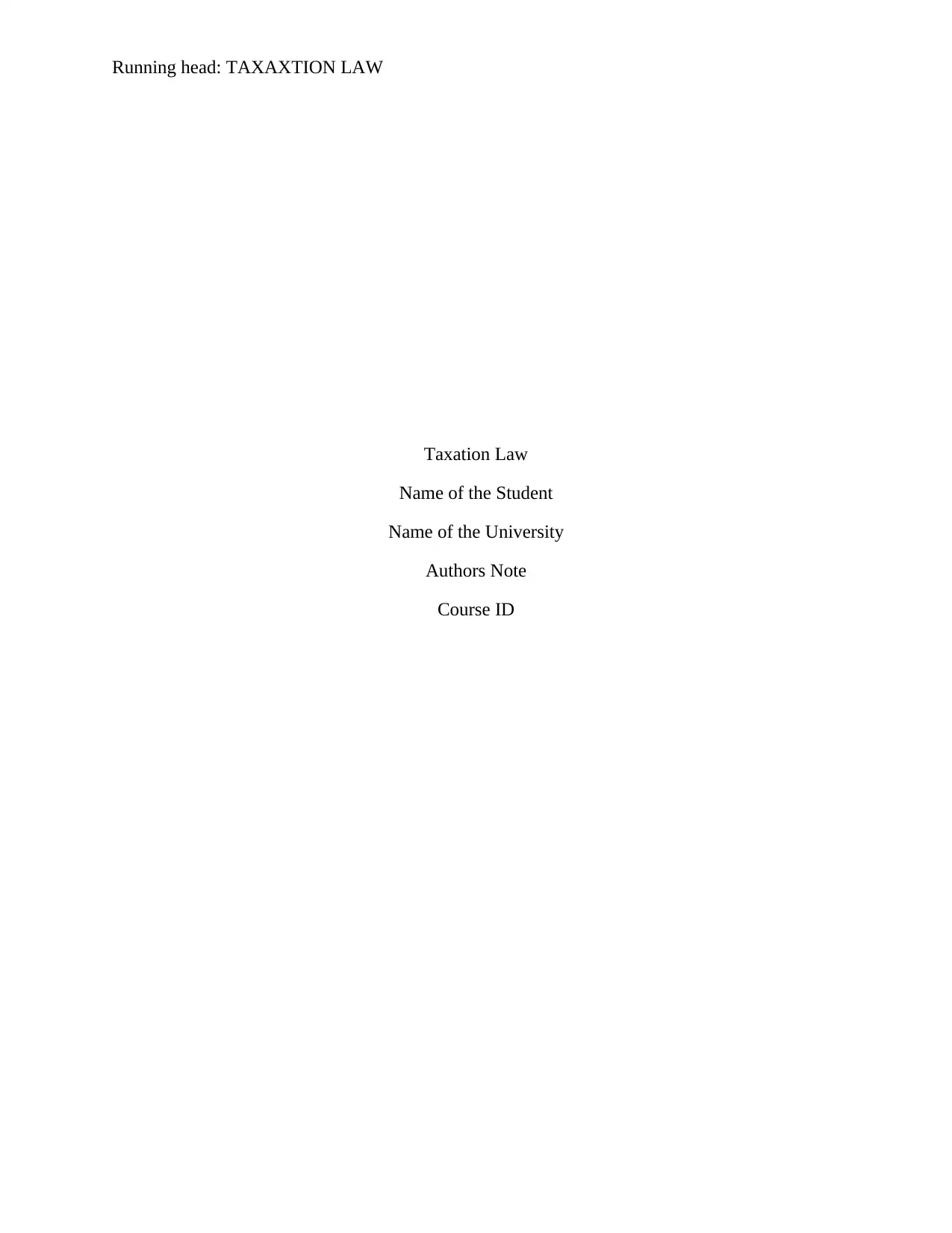
Running head: TAXAXTION LAW
Taxation Law
Name of the Student
Name of the University
Authors Note
Course ID
Taxation Law
Name of the Student
Name of the University
Authors Note
Course ID
Paraphrase This Document
Need a fresh take? Get an instant paraphrase of this document with our AI Paraphraser
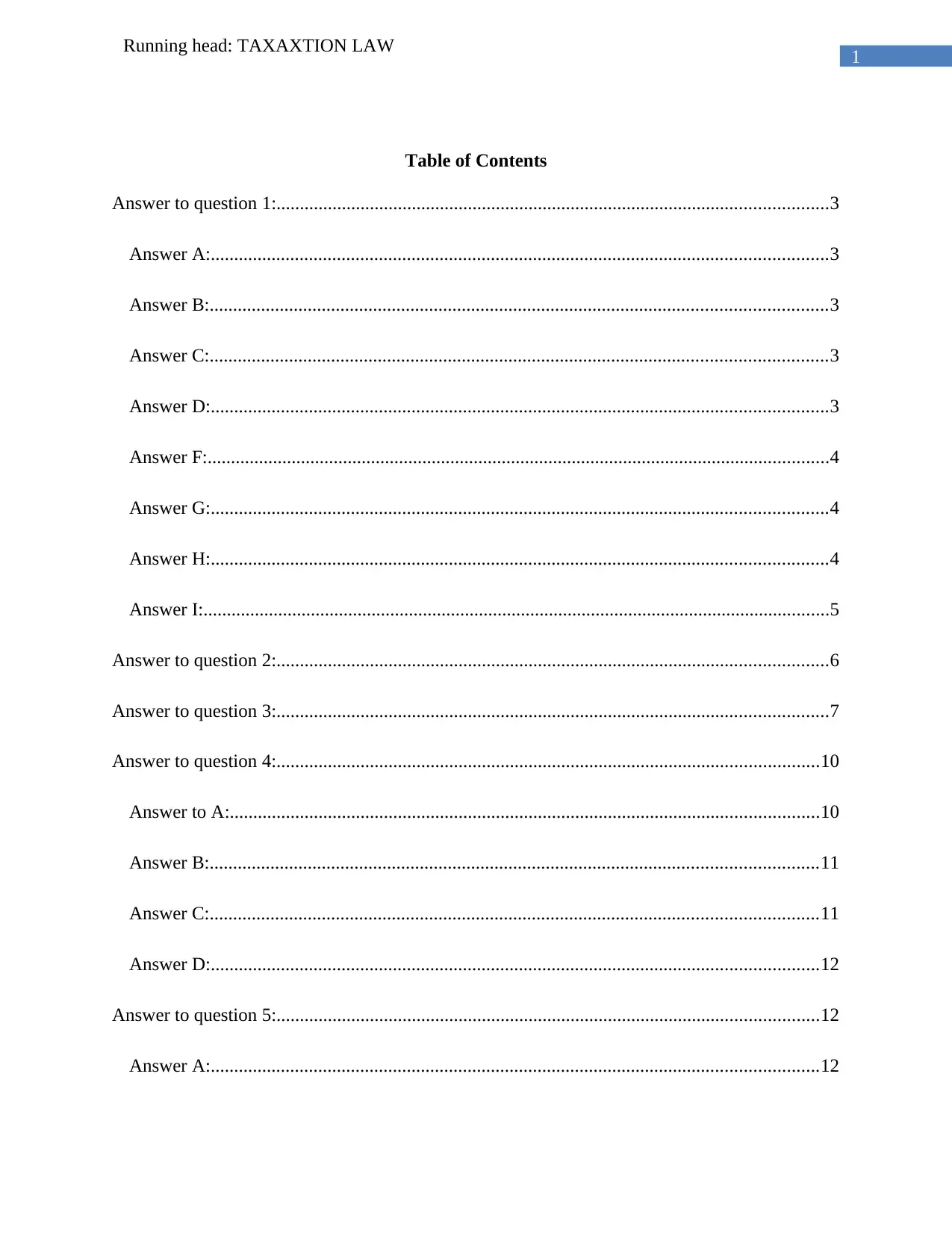
1
Running head: TAXAXTION LAW
Table of Contents
Answer to question 1:......................................................................................................................3
Answer A:....................................................................................................................................3
Answer B:....................................................................................................................................3
Answer C:....................................................................................................................................3
Answer D:....................................................................................................................................3
Answer F:.....................................................................................................................................4
Answer G:....................................................................................................................................4
Answer H:....................................................................................................................................4
Answer I:......................................................................................................................................5
Answer to question 2:......................................................................................................................6
Answer to question 3:......................................................................................................................7
Answer to question 4:....................................................................................................................10
Answer to A:..............................................................................................................................10
Answer B:..................................................................................................................................11
Answer C:..................................................................................................................................11
Answer D:..................................................................................................................................12
Answer to question 5:....................................................................................................................12
Answer A:..................................................................................................................................12
Running head: TAXAXTION LAW
Table of Contents
Answer to question 1:......................................................................................................................3
Answer A:....................................................................................................................................3
Answer B:....................................................................................................................................3
Answer C:....................................................................................................................................3
Answer D:....................................................................................................................................3
Answer F:.....................................................................................................................................4
Answer G:....................................................................................................................................4
Answer H:....................................................................................................................................4
Answer I:......................................................................................................................................5
Answer to question 2:......................................................................................................................6
Answer to question 3:......................................................................................................................7
Answer to question 4:....................................................................................................................10
Answer to A:..............................................................................................................................10
Answer B:..................................................................................................................................11
Answer C:..................................................................................................................................11
Answer D:..................................................................................................................................12
Answer to question 5:....................................................................................................................12
Answer A:..................................................................................................................................12
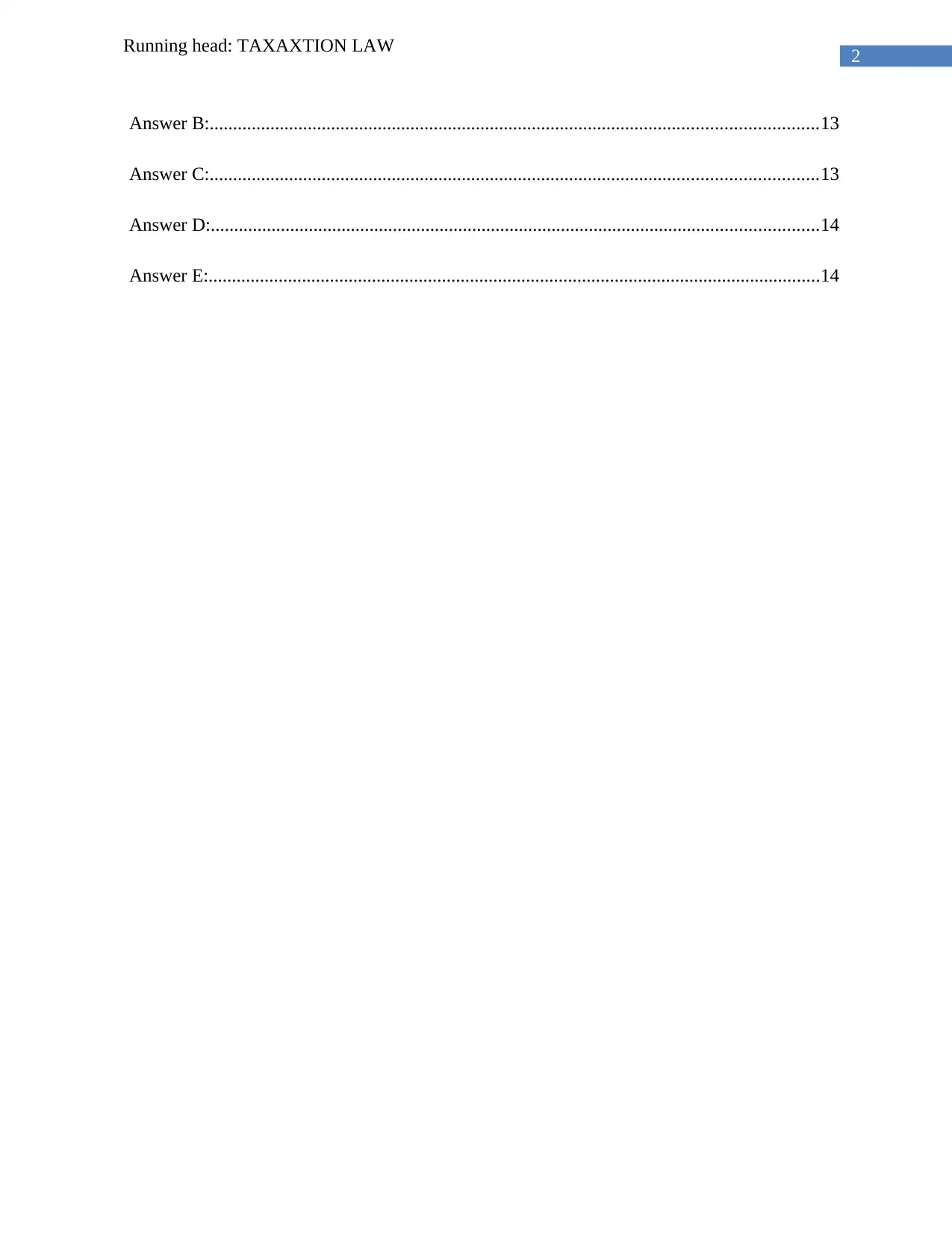
2
Running head: TAXAXTION LAW
Answer B:..................................................................................................................................13
Answer C:..................................................................................................................................13
Answer D:..................................................................................................................................14
Answer E:...................................................................................................................................14
Running head: TAXAXTION LAW
Answer B:..................................................................................................................................13
Answer C:..................................................................................................................................13
Answer D:..................................................................................................................................14
Answer E:...................................................................................................................................14
⊘ This is a preview!⊘
Do you want full access?
Subscribe today to unlock all pages.

Trusted by 1+ million students worldwide
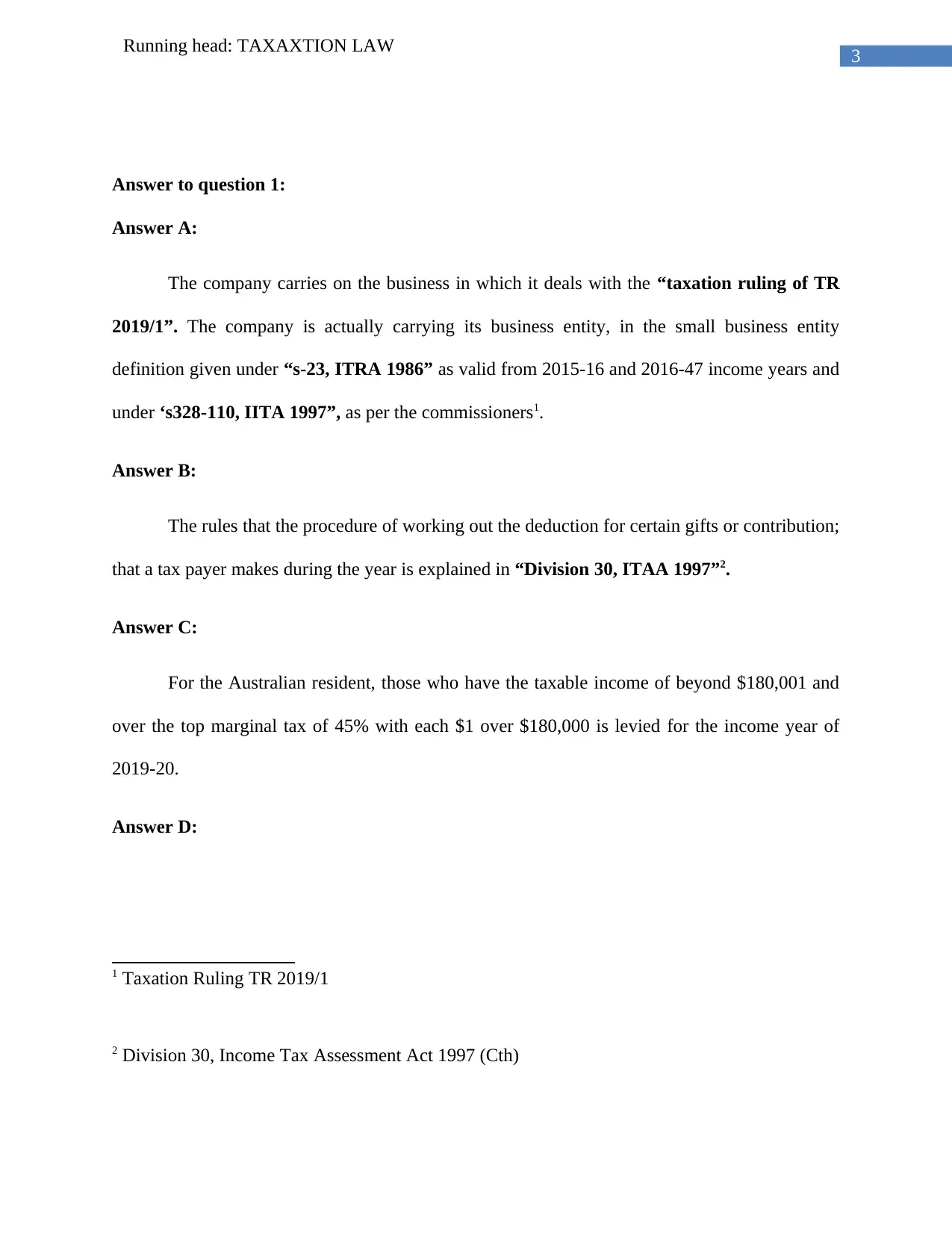
3
Running head: TAXAXTION LAW
Answer to question 1:
Answer A:
The company carries on the business in which it deals with the “taxation ruling of TR
2019/1”. The company is actually carrying its business entity, in the small business entity
definition given under “s-23, ITRA 1986” as valid from 2015-16 and 2016-47 income years and
under ‘s328-110, IITA 1997”, as per the commissioners1.
Answer B:
The rules that the procedure of working out the deduction for certain gifts or contribution;
that a tax payer makes during the year is explained in “Division 30, ITAA 1997”2.
Answer C:
For the Australian resident, those who have the taxable income of beyond $180,001 and
over the top marginal tax of 45% with each $1 over $180,000 is levied for the income year of
2019-20.
Answer D:
1 Taxation Ruling TR 2019/1
2 Division 30, Income Tax Assessment Act 1997 (Cth)
Running head: TAXAXTION LAW
Answer to question 1:
Answer A:
The company carries on the business in which it deals with the “taxation ruling of TR
2019/1”. The company is actually carrying its business entity, in the small business entity
definition given under “s-23, ITRA 1986” as valid from 2015-16 and 2016-47 income years and
under ‘s328-110, IITA 1997”, as per the commissioners1.
Answer B:
The rules that the procedure of working out the deduction for certain gifts or contribution;
that a tax payer makes during the year is explained in “Division 30, ITAA 1997”2.
Answer C:
For the Australian resident, those who have the taxable income of beyond $180,001 and
over the top marginal tax of 45% with each $1 over $180,000 is levied for the income year of
2019-20.
Answer D:
1 Taxation Ruling TR 2019/1
2 Division 30, Income Tax Assessment Act 1997 (Cth)
Paraphrase This Document
Need a fresh take? Get an instant paraphrase of this document with our AI Paraphraser
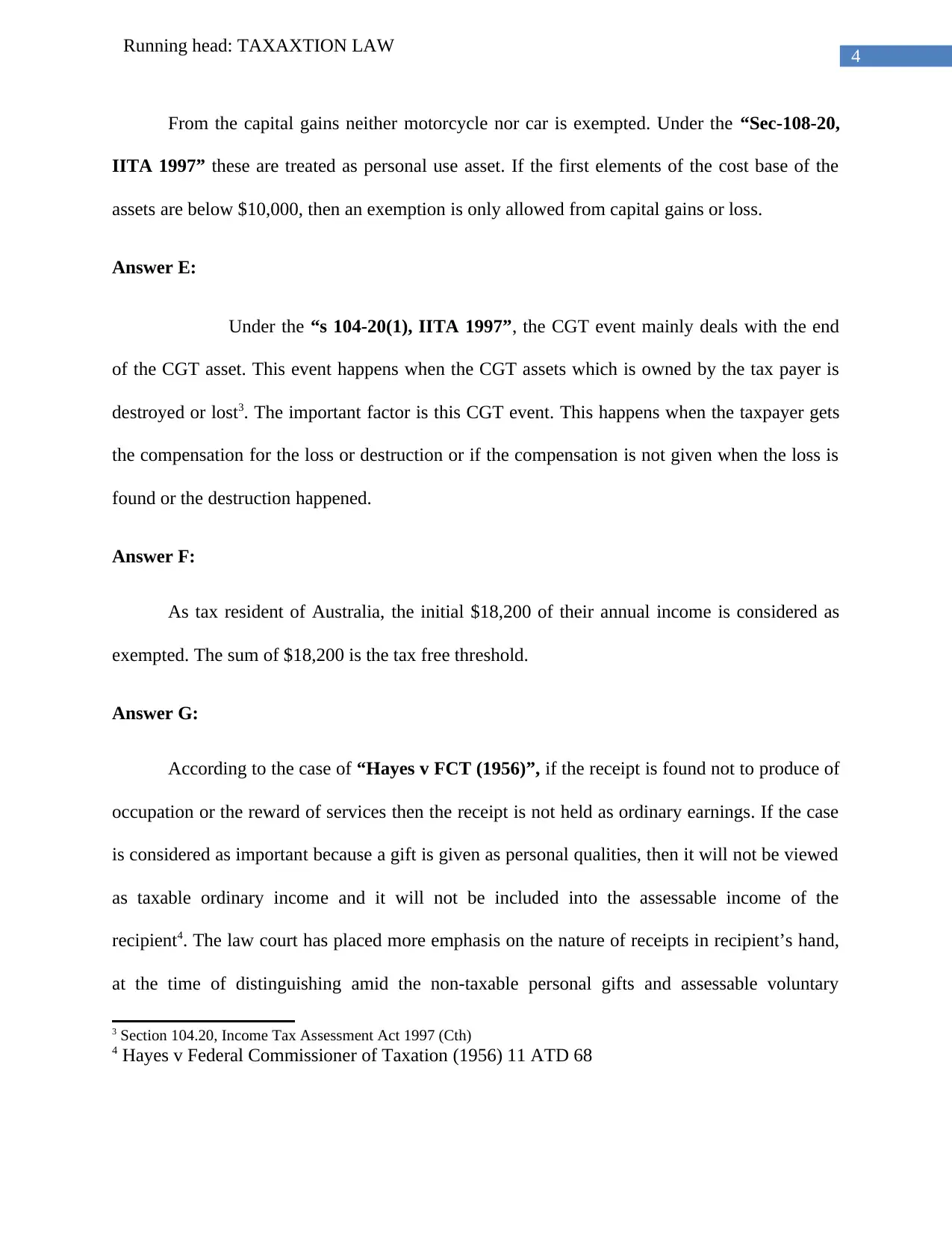
4
Running head: TAXAXTION LAW
From the capital gains neither motorcycle nor car is exempted. Under the “Sec-108-20,
IITA 1997” these are treated as personal use asset. If the first elements of the cost base of the
assets are below $10,000, then an exemption is only allowed from capital gains or loss.
Answer E:
Under the “s 104-20(1), IITA 1997”, the CGT event mainly deals with the end
of the CGT asset. This event happens when the CGT assets which is owned by the tax payer is
destroyed or lost3. The important factor is this CGT event. This happens when the taxpayer gets
the compensation for the loss or destruction or if the compensation is not given when the loss is
found or the destruction happened.
Answer F:
As tax resident of Australia, the initial $18,200 of their annual income is considered as
exempted. The sum of $18,200 is the tax free threshold.
Answer G:
According to the case of “Hayes v FCT (1956)”, if the receipt is found not to produce of
occupation or the reward of services then the receipt is not held as ordinary earnings. If the case
is considered as important because a gift is given as personal qualities, then it will not be viewed
as taxable ordinary income and it will not be included into the assessable income of the
recipient4. The law court has placed more emphasis on the nature of receipts in recipient’s hand,
at the time of distinguishing amid the non-taxable personal gifts and assessable voluntary
3 Section 104.20, Income Tax Assessment Act 1997 (Cth)
4 Hayes v Federal Commissioner of Taxation (1956) 11 ATD 68
Running head: TAXAXTION LAW
From the capital gains neither motorcycle nor car is exempted. Under the “Sec-108-20,
IITA 1997” these are treated as personal use asset. If the first elements of the cost base of the
assets are below $10,000, then an exemption is only allowed from capital gains or loss.
Answer E:
Under the “s 104-20(1), IITA 1997”, the CGT event mainly deals with the end
of the CGT asset. This event happens when the CGT assets which is owned by the tax payer is
destroyed or lost3. The important factor is this CGT event. This happens when the taxpayer gets
the compensation for the loss or destruction or if the compensation is not given when the loss is
found or the destruction happened.
Answer F:
As tax resident of Australia, the initial $18,200 of their annual income is considered as
exempted. The sum of $18,200 is the tax free threshold.
Answer G:
According to the case of “Hayes v FCT (1956)”, if the receipt is found not to produce of
occupation or the reward of services then the receipt is not held as ordinary earnings. If the case
is considered as important because a gift is given as personal qualities, then it will not be viewed
as taxable ordinary income and it will not be included into the assessable income of the
recipient4. The law court has placed more emphasis on the nature of receipts in recipient’s hand,
at the time of distinguishing amid the non-taxable personal gifts and assessable voluntary
3 Section 104.20, Income Tax Assessment Act 1997 (Cth)
4 Hayes v Federal Commissioner of Taxation (1956) 11 ATD 68
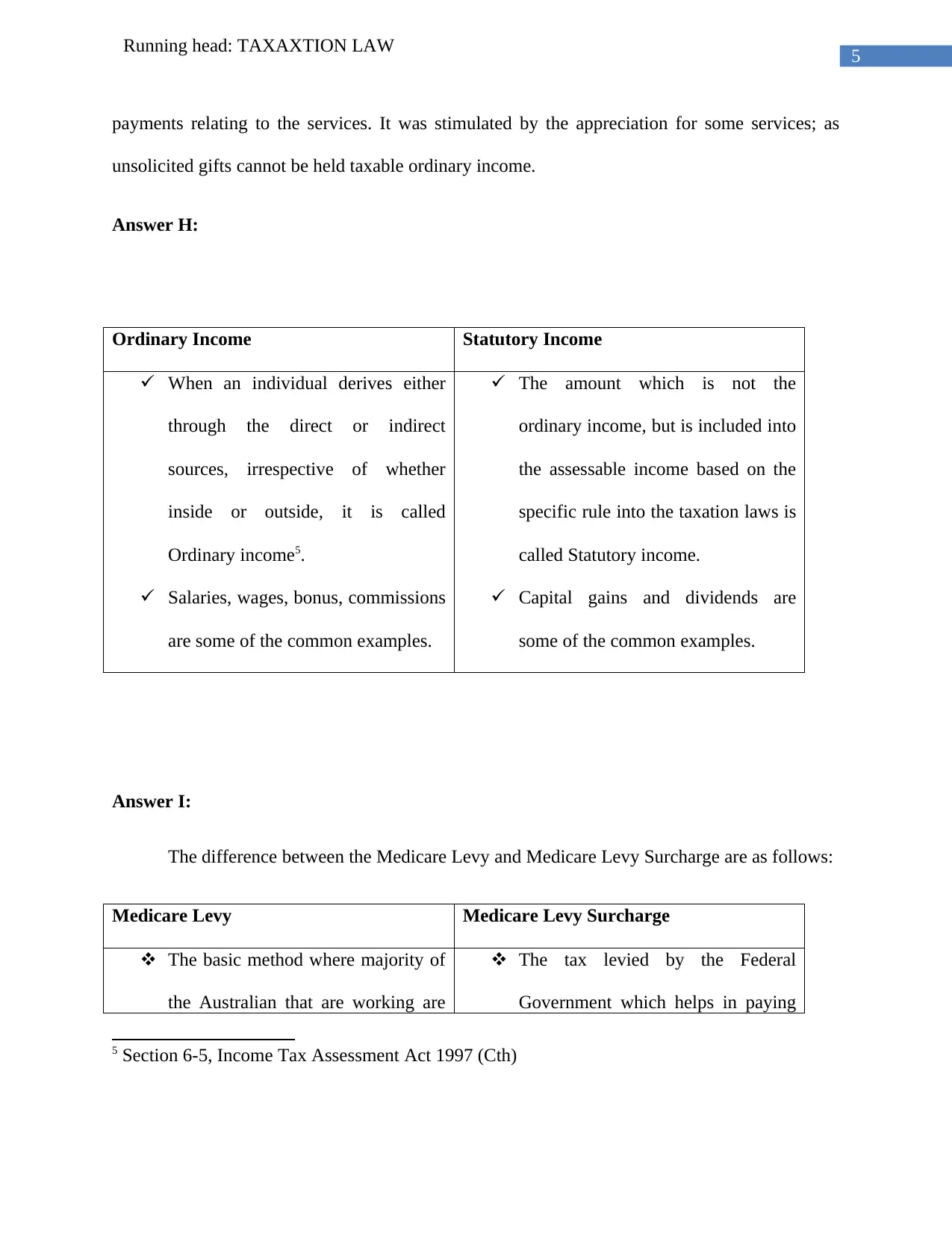
5
Running head: TAXAXTION LAW
payments relating to the services. It was stimulated by the appreciation for some services; as
unsolicited gifts cannot be held taxable ordinary income.
Answer H:
Ordinary Income Statutory Income
When an individual derives either
through the direct or indirect
sources, irrespective of whether
inside or outside, it is called
Ordinary income5.
Salaries, wages, bonus, commissions
are some of the common examples.
The amount which is not the
ordinary income, but is included into
the assessable income based on the
specific rule into the taxation laws is
called Statutory income.
Capital gains and dividends are
some of the common examples.
Answer I:
The difference between the Medicare Levy and Medicare Levy Surcharge are as follows:
Medicare Levy Medicare Levy Surcharge
The basic method where majority of
the Australian that are working are
The tax levied by the Federal
Government which helps in paying
5 Section 6-5, Income Tax Assessment Act 1997 (Cth)
Running head: TAXAXTION LAW
payments relating to the services. It was stimulated by the appreciation for some services; as
unsolicited gifts cannot be held taxable ordinary income.
Answer H:
Ordinary Income Statutory Income
When an individual derives either
through the direct or indirect
sources, irrespective of whether
inside or outside, it is called
Ordinary income5.
Salaries, wages, bonus, commissions
are some of the common examples.
The amount which is not the
ordinary income, but is included into
the assessable income based on the
specific rule into the taxation laws is
called Statutory income.
Capital gains and dividends are
some of the common examples.
Answer I:
The difference between the Medicare Levy and Medicare Levy Surcharge are as follows:
Medicare Levy Medicare Levy Surcharge
The basic method where majority of
the Australian that are working are
The tax levied by the Federal
Government which helps in paying
5 Section 6-5, Income Tax Assessment Act 1997 (Cth)
⊘ This is a preview!⊘
Do you want full access?
Subscribe today to unlock all pages.

Trusted by 1+ million students worldwide
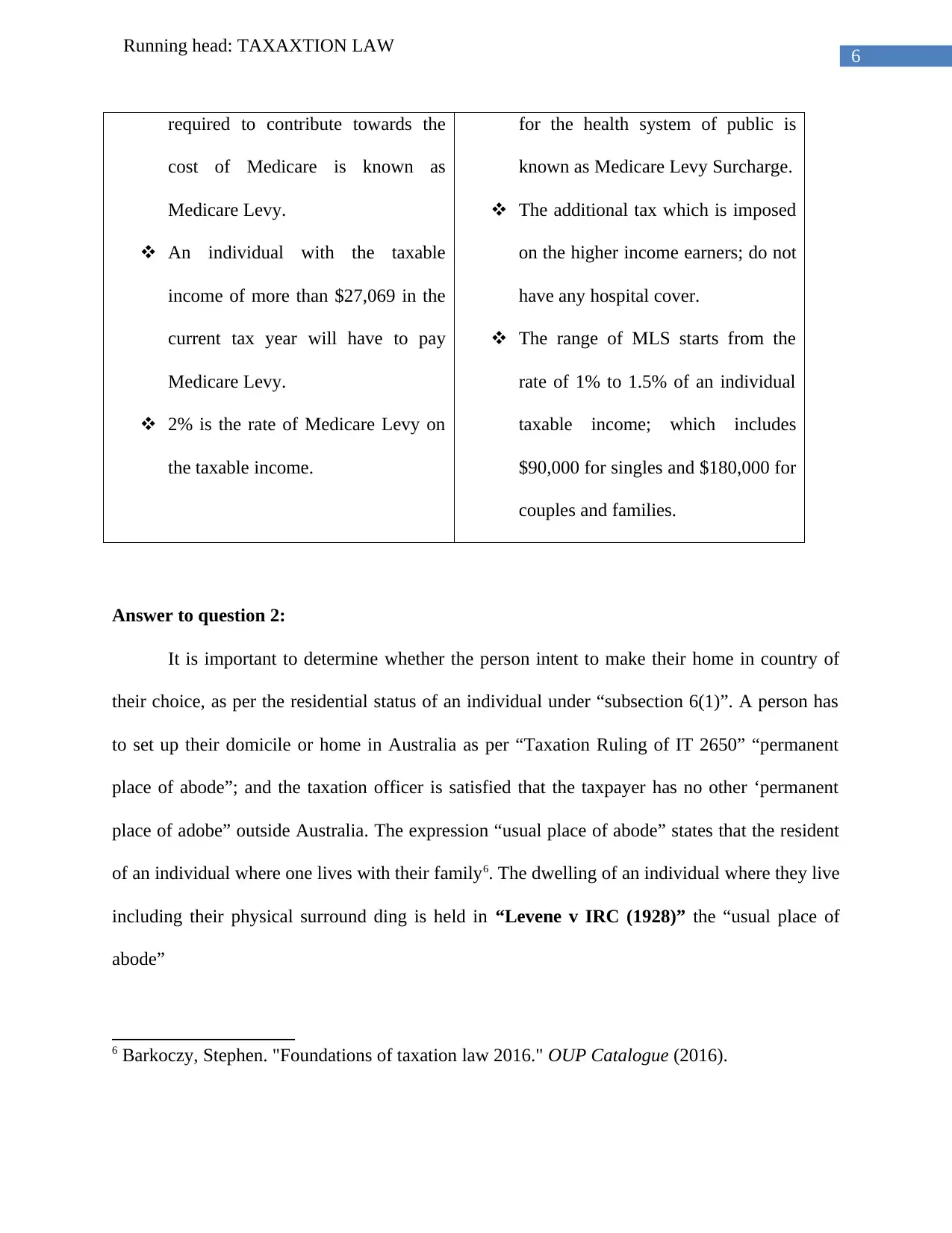
6
Running head: TAXAXTION LAW
required to contribute towards the
cost of Medicare is known as
Medicare Levy.
An individual with the taxable
income of more than $27,069 in the
current tax year will have to pay
Medicare Levy.
2% is the rate of Medicare Levy on
the taxable income.
for the health system of public is
known as Medicare Levy Surcharge.
The additional tax which is imposed
on the higher income earners; do not
have any hospital cover.
The range of MLS starts from the
rate of 1% to 1.5% of an individual
taxable income; which includes
$90,000 for singles and $180,000 for
couples and families.
Answer to question 2:
It is important to determine whether the person intent to make their home in country of
their choice, as per the residential status of an individual under “subsection 6(1)”. A person has
to set up their domicile or home in Australia as per “Taxation Ruling of IT 2650” “permanent
place of abode”; and the taxation officer is satisfied that the taxpayer has no other ‘permanent
place of adobe” outside Australia. The expression “usual place of abode” states that the resident
of an individual where one lives with their family6. The dwelling of an individual where they live
including their physical surround ding is held in “Levene v IRC (1928)” the “usual place of
abode”
6 Barkoczy, Stephen. "Foundations of taxation law 2016." OUP Catalogue (2016).
Running head: TAXAXTION LAW
required to contribute towards the
cost of Medicare is known as
Medicare Levy.
An individual with the taxable
income of more than $27,069 in the
current tax year will have to pay
Medicare Levy.
2% is the rate of Medicare Levy on
the taxable income.
for the health system of public is
known as Medicare Levy Surcharge.
The additional tax which is imposed
on the higher income earners; do not
have any hospital cover.
The range of MLS starts from the
rate of 1% to 1.5% of an individual
taxable income; which includes
$90,000 for singles and $180,000 for
couples and families.
Answer to question 2:
It is important to determine whether the person intent to make their home in country of
their choice, as per the residential status of an individual under “subsection 6(1)”. A person has
to set up their domicile or home in Australia as per “Taxation Ruling of IT 2650” “permanent
place of abode”; and the taxation officer is satisfied that the taxpayer has no other ‘permanent
place of adobe” outside Australia. The expression “usual place of abode” states that the resident
of an individual where one lives with their family6. The dwelling of an individual where they live
including their physical surround ding is held in “Levene v IRC (1928)” the “usual place of
abode”
6 Barkoczy, Stephen. "Foundations of taxation law 2016." OUP Catalogue (2016).
Paraphrase This Document
Need a fresh take? Get an instant paraphrase of this document with our AI Paraphraser
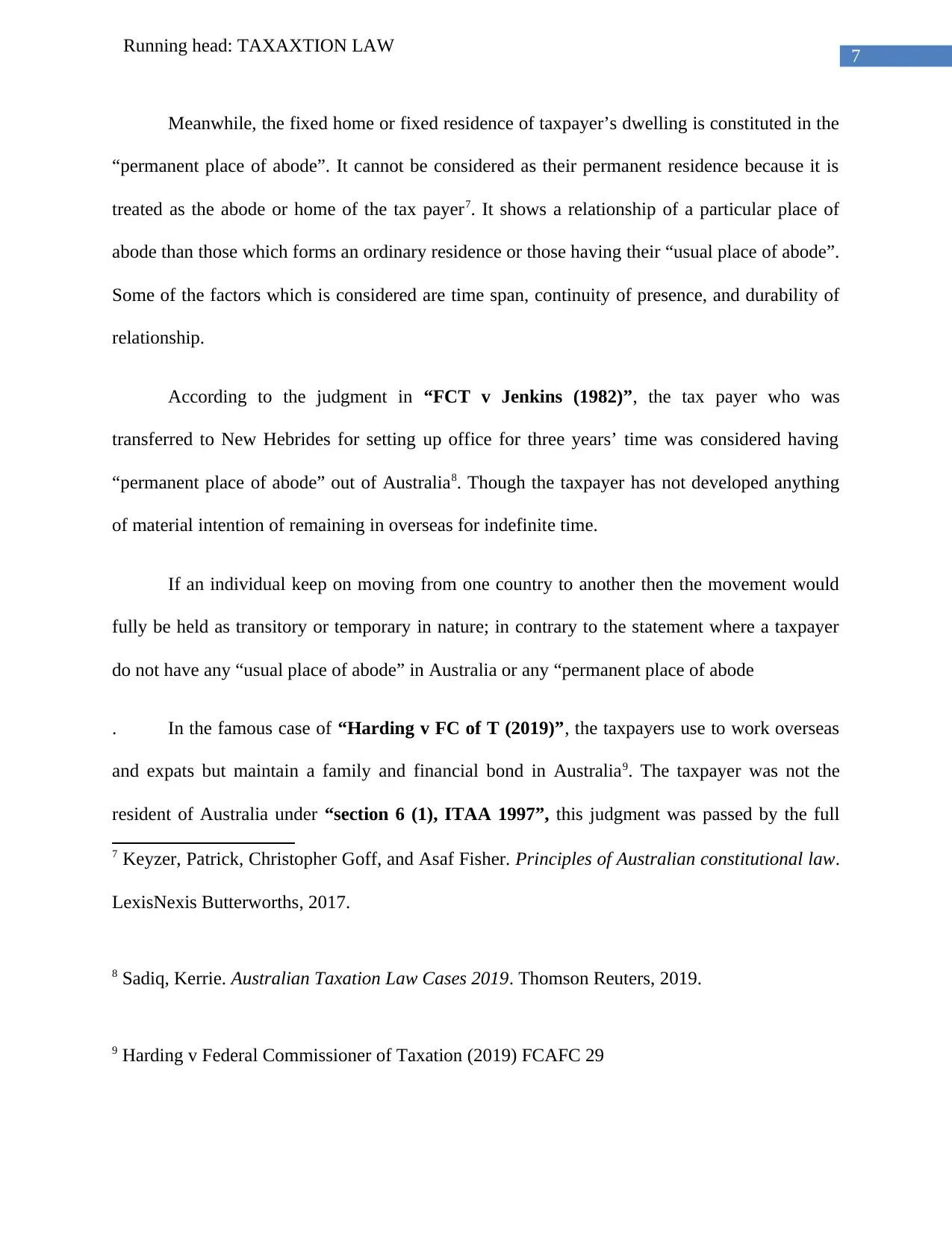
7
Running head: TAXAXTION LAW
Meanwhile, the fixed home or fixed residence of taxpayer’s dwelling is constituted in the
“permanent place of abode”. It cannot be considered as their permanent residence because it is
treated as the abode or home of the tax payer7. It shows a relationship of a particular place of
abode than those which forms an ordinary residence or those having their “usual place of abode”.
Some of the factors which is considered are time span, continuity of presence, and durability of
relationship.
According to the judgment in “FCT v Jenkins (1982)”, the tax payer who was
transferred to New Hebrides for setting up office for three years’ time was considered having
“permanent place of abode” out of Australia8. Though the taxpayer has not developed anything
of material intention of remaining in overseas for indefinite time.
If an individual keep on moving from one country to another then the movement would
fully be held as transitory or temporary in nature; in contrary to the statement where a taxpayer
do not have any “usual place of abode” in Australia or any “permanent place of abode
. In the famous case of “Harding v FC of T (2019)”, the taxpayers use to work overseas
and expats but maintain a family and financial bond in Australia9. The taxpayer was not the
resident of Australia under “section 6 (1), ITAA 1997”, this judgment was passed by the full
7 Keyzer, Patrick, Christopher Goff, and Asaf Fisher. Principles of Australian constitutional law.
LexisNexis Butterworths, 2017.
8 Sadiq, Kerrie. Australian Taxation Law Cases 2019. Thomson Reuters, 2019.
9 Harding v Federal Commissioner of Taxation (2019) FCAFC 29
Running head: TAXAXTION LAW
Meanwhile, the fixed home or fixed residence of taxpayer’s dwelling is constituted in the
“permanent place of abode”. It cannot be considered as their permanent residence because it is
treated as the abode or home of the tax payer7. It shows a relationship of a particular place of
abode than those which forms an ordinary residence or those having their “usual place of abode”.
Some of the factors which is considered are time span, continuity of presence, and durability of
relationship.
According to the judgment in “FCT v Jenkins (1982)”, the tax payer who was
transferred to New Hebrides for setting up office for three years’ time was considered having
“permanent place of abode” out of Australia8. Though the taxpayer has not developed anything
of material intention of remaining in overseas for indefinite time.
If an individual keep on moving from one country to another then the movement would
fully be held as transitory or temporary in nature; in contrary to the statement where a taxpayer
do not have any “usual place of abode” in Australia or any “permanent place of abode
. In the famous case of “Harding v FC of T (2019)”, the taxpayers use to work overseas
and expats but maintain a family and financial bond in Australia9. The taxpayer was not the
resident of Australia under “section 6 (1), ITAA 1997”, this judgment was passed by the full
7 Keyzer, Patrick, Christopher Goff, and Asaf Fisher. Principles of Australian constitutional law.
LexisNexis Butterworths, 2017.
8 Sadiq, Kerrie. Australian Taxation Law Cases 2019. Thomson Reuters, 2019.
9 Harding v Federal Commissioner of Taxation (2019) FCAFC 29
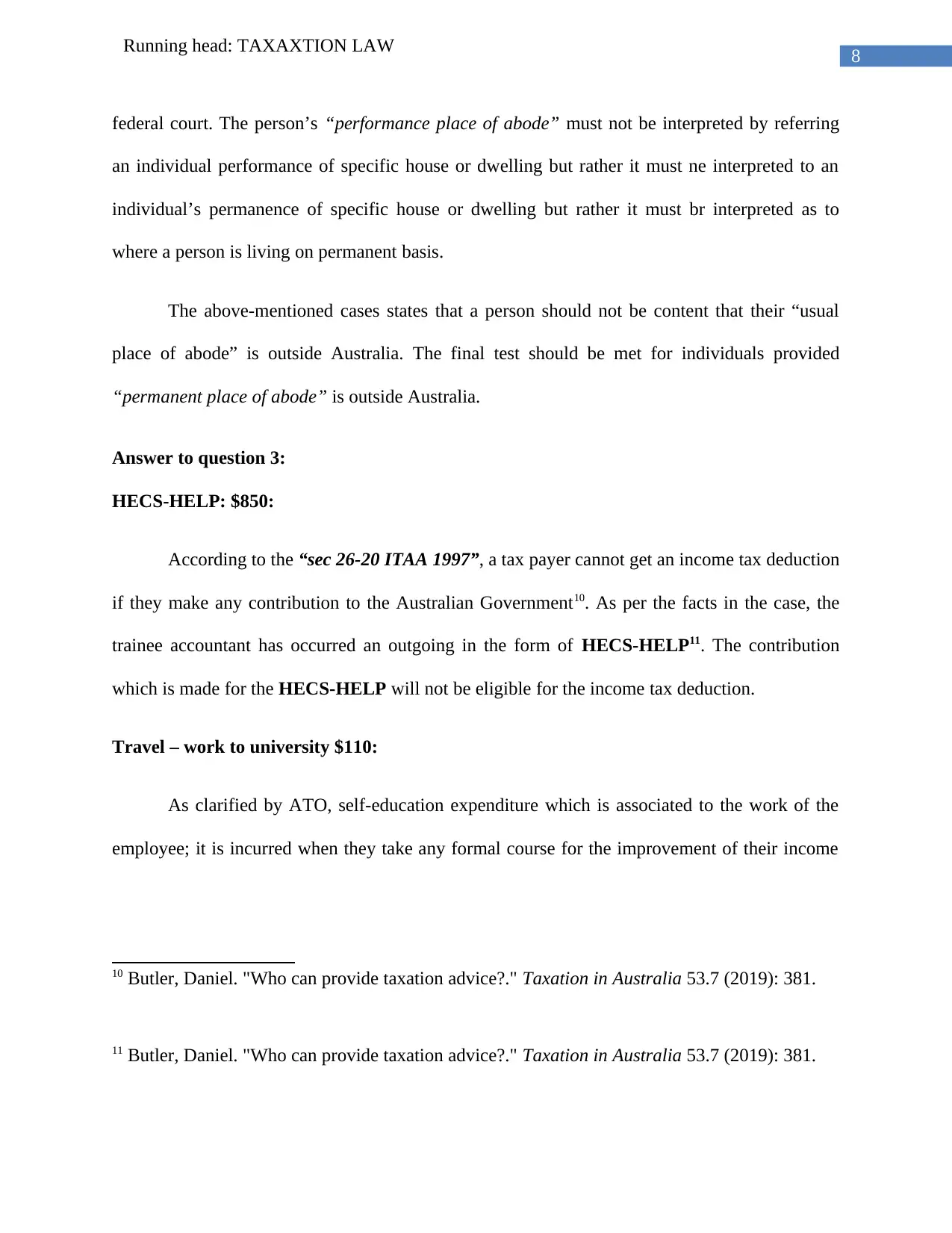
8
Running head: TAXAXTION LAW
federal court. The person’s “performance place of abode” must not be interpreted by referring
an individual performance of specific house or dwelling but rather it must ne interpreted to an
individual’s permanence of specific house or dwelling but rather it must br interpreted as to
where a person is living on permanent basis.
The above-mentioned cases states that a person should not be content that their “usual
place of abode” is outside Australia. The final test should be met for individuals provided
“permanent place of abode” is outside Australia.
Answer to question 3:
HECS-HELP: $850:
According to the “sec 26-20 ITAA 1997”, a tax payer cannot get an income tax deduction
if they make any contribution to the Australian Government10. As per the facts in the case, the
trainee accountant has occurred an outgoing in the form of HECS-HELP11. The contribution
which is made for the HECS-HELP will not be eligible for the income tax deduction.
Travel – work to university $110:
As clarified by ATO, self-education expenditure which is associated to the work of the
employee; it is incurred when they take any formal course for the improvement of their income
10 Butler, Daniel. "Who can provide taxation advice?." Taxation in Australia 53.7 (2019): 381.
11 Butler, Daniel. "Who can provide taxation advice?." Taxation in Australia 53.7 (2019): 381.
Running head: TAXAXTION LAW
federal court. The person’s “performance place of abode” must not be interpreted by referring
an individual performance of specific house or dwelling but rather it must ne interpreted to an
individual’s permanence of specific house or dwelling but rather it must br interpreted as to
where a person is living on permanent basis.
The above-mentioned cases states that a person should not be content that their “usual
place of abode” is outside Australia. The final test should be met for individuals provided
“permanent place of abode” is outside Australia.
Answer to question 3:
HECS-HELP: $850:
According to the “sec 26-20 ITAA 1997”, a tax payer cannot get an income tax deduction
if they make any contribution to the Australian Government10. As per the facts in the case, the
trainee accountant has occurred an outgoing in the form of HECS-HELP11. The contribution
which is made for the HECS-HELP will not be eligible for the income tax deduction.
Travel – work to university $110:
As clarified by ATO, self-education expenditure which is associated to the work of the
employee; it is incurred when they take any formal course for the improvement of their income
10 Butler, Daniel. "Who can provide taxation advice?." Taxation in Australia 53.7 (2019): 381.
11 Butler, Daniel. "Who can provide taxation advice?." Taxation in Australia 53.7 (2019): 381.
⊘ This is a preview!⊘
Do you want full access?
Subscribe today to unlock all pages.

Trusted by 1+ million students worldwide
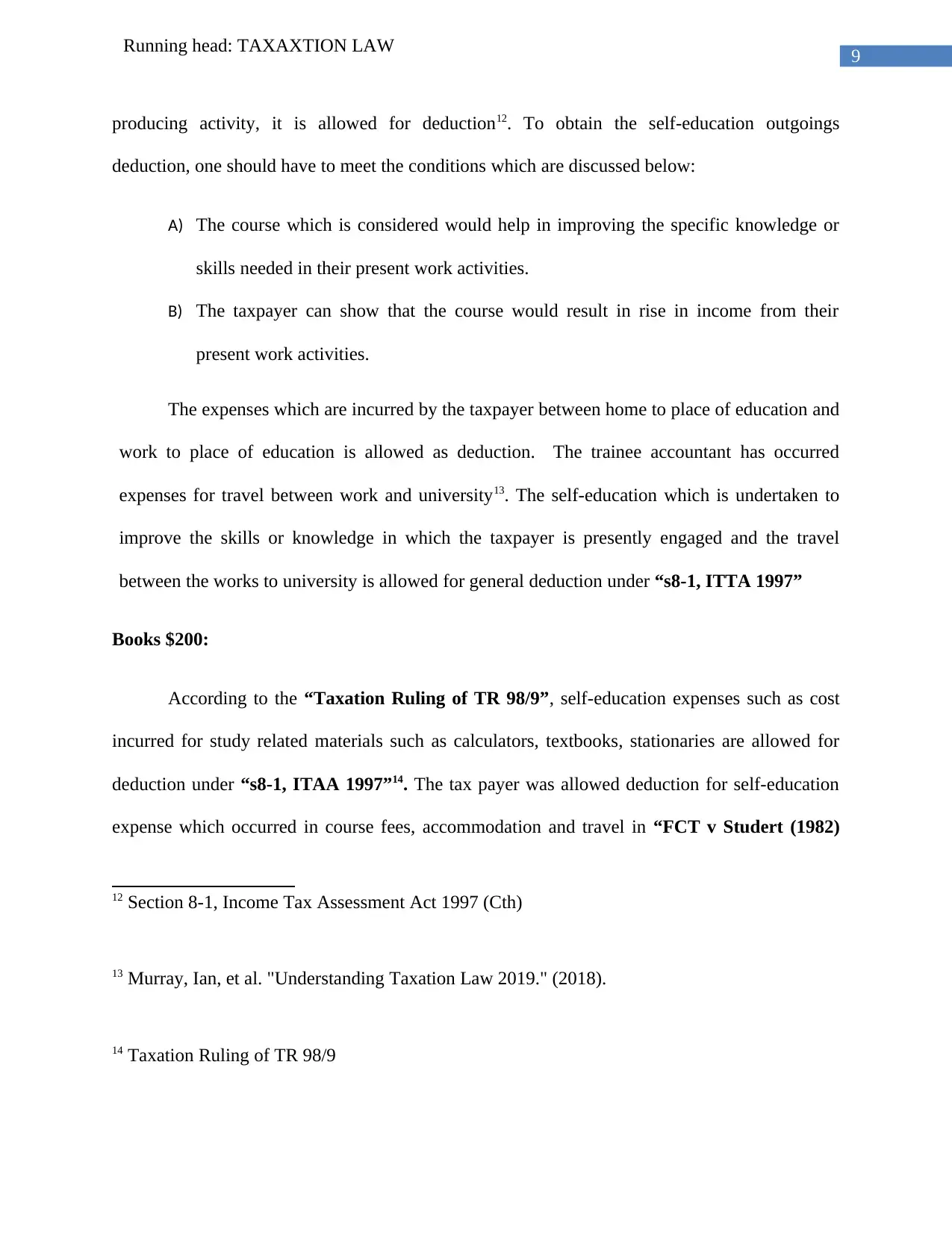
9
Running head: TAXAXTION LAW
producing activity, it is allowed for deduction12. To obtain the self-education outgoings
deduction, one should have to meet the conditions which are discussed below:
A) The course which is considered would help in improving the specific knowledge or
skills needed in their present work activities.
B) The taxpayer can show that the course would result in rise in income from their
present work activities.
The expenses which are incurred by the taxpayer between home to place of education and
work to place of education is allowed as deduction. The trainee accountant has occurred
expenses for travel between work and university13. The self-education which is undertaken to
improve the skills or knowledge in which the taxpayer is presently engaged and the travel
between the works to university is allowed for general deduction under “s8-1, ITTA 1997”
Books $200:
According to the “Taxation Ruling of TR 98/9”, self-education expenses such as cost
incurred for study related materials such as calculators, textbooks, stationaries are allowed for
deduction under “s8-1, ITAA 1997”14. The tax payer was allowed deduction for self-education
expense which occurred in course fees, accommodation and travel in “FCT v Studert (1982)
12 Section 8-1, Income Tax Assessment Act 1997 (Cth)
13 Murray, Ian, et al. "Understanding Taxation Law 2019." (2018).
14 Taxation Ruling of TR 98/9
Running head: TAXAXTION LAW
producing activity, it is allowed for deduction12. To obtain the self-education outgoings
deduction, one should have to meet the conditions which are discussed below:
A) The course which is considered would help in improving the specific knowledge or
skills needed in their present work activities.
B) The taxpayer can show that the course would result in rise in income from their
present work activities.
The expenses which are incurred by the taxpayer between home to place of education and
work to place of education is allowed as deduction. The trainee accountant has occurred
expenses for travel between work and university13. The self-education which is undertaken to
improve the skills or knowledge in which the taxpayer is presently engaged and the travel
between the works to university is allowed for general deduction under “s8-1, ITTA 1997”
Books $200:
According to the “Taxation Ruling of TR 98/9”, self-education expenses such as cost
incurred for study related materials such as calculators, textbooks, stationaries are allowed for
deduction under “s8-1, ITAA 1997”14. The tax payer was allowed deduction for self-education
expense which occurred in course fees, accommodation and travel in “FCT v Studert (1982)
12 Section 8-1, Income Tax Assessment Act 1997 (Cth)
13 Murray, Ian, et al. "Understanding Taxation Law 2019." (2018).
14 Taxation Ruling of TR 98/9
Paraphrase This Document
Need a fresh take? Get an instant paraphrase of this document with our AI Paraphraser
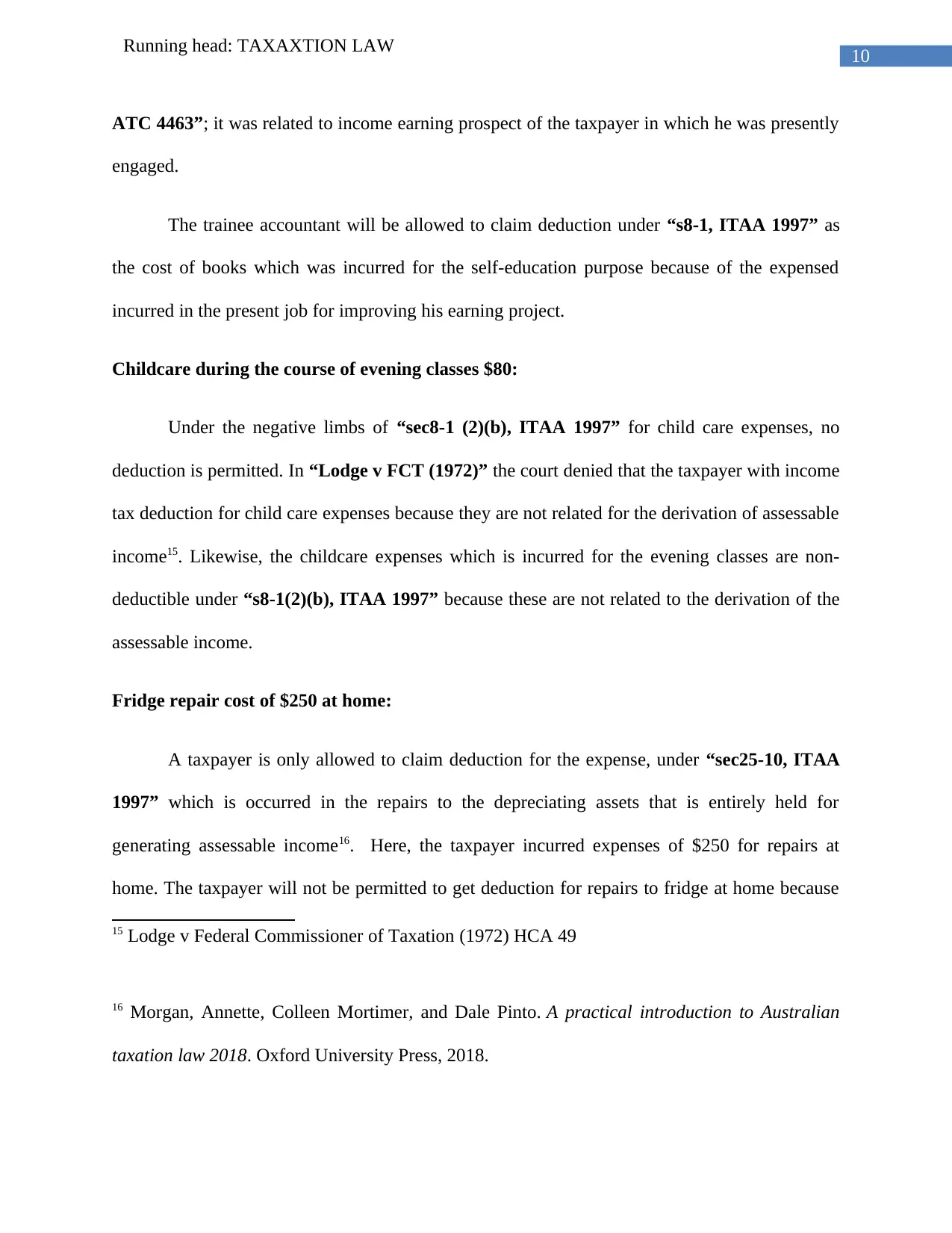
10
Running head: TAXAXTION LAW
ATC 4463”; it was related to income earning prospect of the taxpayer in which he was presently
engaged.
The trainee accountant will be allowed to claim deduction under “s8-1, ITAA 1997” as
the cost of books which was incurred for the self-education purpose because of the expensed
incurred in the present job for improving his earning project.
Childcare during the course of evening classes $80:
Under the negative limbs of “sec8-1 (2)(b), ITAA 1997” for child care expenses, no
deduction is permitted. In “Lodge v FCT (1972)” the court denied that the taxpayer with income
tax deduction for child care expenses because they are not related for the derivation of assessable
income15. Likewise, the childcare expenses which is incurred for the evening classes are non-
deductible under “s8-1(2)(b), ITAA 1997” because these are not related to the derivation of the
assessable income.
Fridge repair cost of $250 at home:
A taxpayer is only allowed to claim deduction for the expense, under “sec25-10, ITAA
1997” which is occurred in the repairs to the depreciating assets that is entirely held for
generating assessable income16. Here, the taxpayer incurred expenses of $250 for repairs at
home. The taxpayer will not be permitted to get deduction for repairs to fridge at home because
15 Lodge v Federal Commissioner of Taxation (1972) HCA 49
16 Morgan, Annette, Colleen Mortimer, and Dale Pinto. A practical introduction to Australian
taxation law 2018. Oxford University Press, 2018.
Running head: TAXAXTION LAW
ATC 4463”; it was related to income earning prospect of the taxpayer in which he was presently
engaged.
The trainee accountant will be allowed to claim deduction under “s8-1, ITAA 1997” as
the cost of books which was incurred for the self-education purpose because of the expensed
incurred in the present job for improving his earning project.
Childcare during the course of evening classes $80:
Under the negative limbs of “sec8-1 (2)(b), ITAA 1997” for child care expenses, no
deduction is permitted. In “Lodge v FCT (1972)” the court denied that the taxpayer with income
tax deduction for child care expenses because they are not related for the derivation of assessable
income15. Likewise, the childcare expenses which is incurred for the evening classes are non-
deductible under “s8-1(2)(b), ITAA 1997” because these are not related to the derivation of the
assessable income.
Fridge repair cost of $250 at home:
A taxpayer is only allowed to claim deduction for the expense, under “sec25-10, ITAA
1997” which is occurred in the repairs to the depreciating assets that is entirely held for
generating assessable income16. Here, the taxpayer incurred expenses of $250 for repairs at
home. The taxpayer will not be permitted to get deduction for repairs to fridge at home because
15 Lodge v Federal Commissioner of Taxation (1972) HCA 49
16 Morgan, Annette, Colleen Mortimer, and Dale Pinto. A practical introduction to Australian
taxation law 2018. Oxford University Press, 2018.
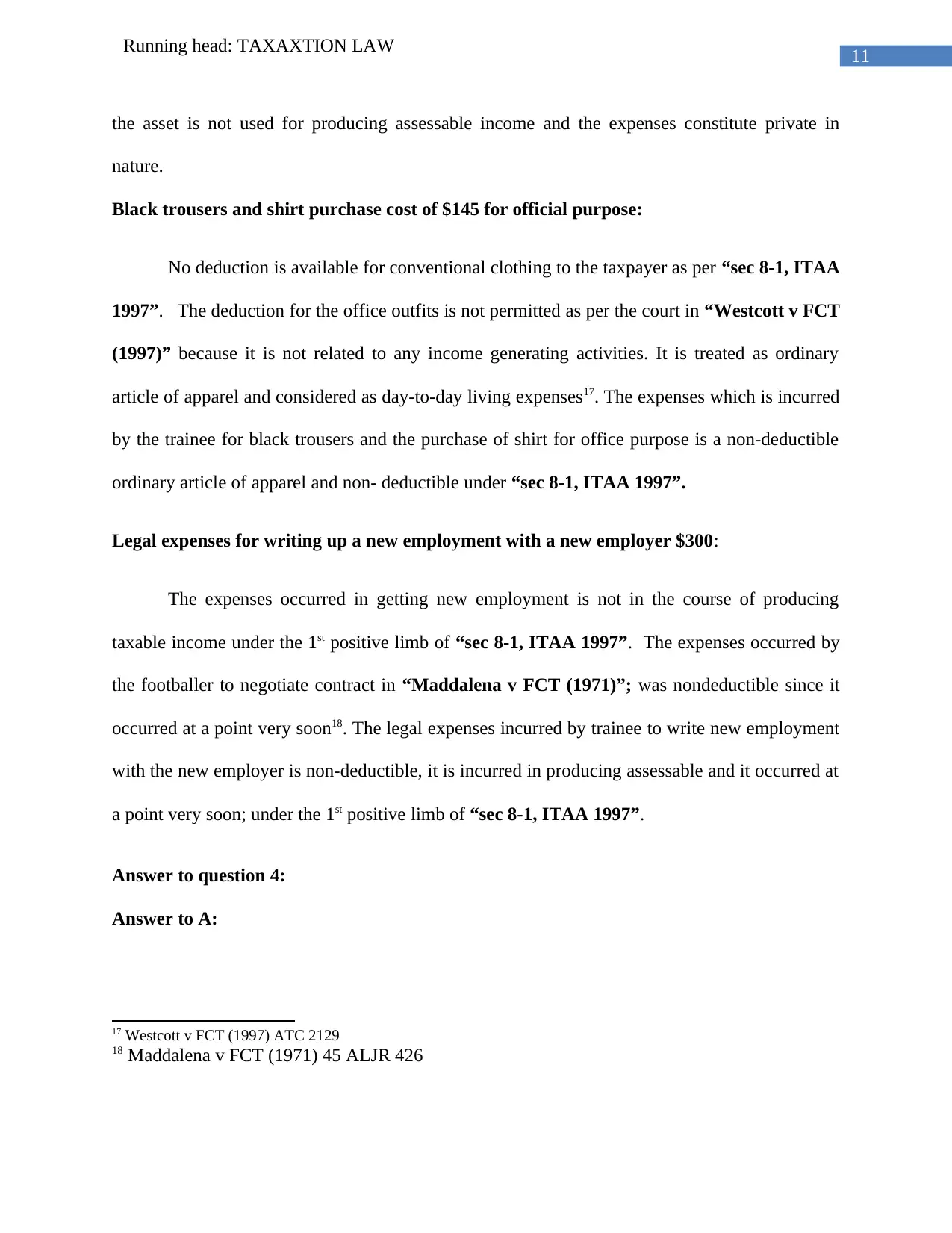
11
Running head: TAXAXTION LAW
the asset is not used for producing assessable income and the expenses constitute private in
nature.
Black trousers and shirt purchase cost of $145 for official purpose:
No deduction is available for conventional clothing to the taxpayer as per “sec 8-1, ITAA
1997”. The deduction for the office outfits is not permitted as per the court in “Westcott v FCT
(1997)” because it is not related to any income generating activities. It is treated as ordinary
article of apparel and considered as day-to-day living expenses17. The expenses which is incurred
by the trainee for black trousers and the purchase of shirt for office purpose is a non-deductible
ordinary article of apparel and non- deductible under “sec 8-1, ITAA 1997”.
Legal expenses for writing up a new employment with a new employer $300:
The expenses occurred in getting new employment is not in the course of producing
taxable income under the 1st positive limb of “sec 8-1, ITAA 1997”. The expenses occurred by
the footballer to negotiate contract in “Maddalena v FCT (1971)”; was nondeductible since it
occurred at a point very soon18. The legal expenses incurred by trainee to write new employment
with the new employer is non-deductible, it is incurred in producing assessable and it occurred at
a point very soon; under the 1st positive limb of “sec 8-1, ITAA 1997”.
Answer to question 4:
Answer to A:
17 Westcott v FCT (1997) ATC 2129
18 Maddalena v FCT (1971) 45 ALJR 426
Running head: TAXAXTION LAW
the asset is not used for producing assessable income and the expenses constitute private in
nature.
Black trousers and shirt purchase cost of $145 for official purpose:
No deduction is available for conventional clothing to the taxpayer as per “sec 8-1, ITAA
1997”. The deduction for the office outfits is not permitted as per the court in “Westcott v FCT
(1997)” because it is not related to any income generating activities. It is treated as ordinary
article of apparel and considered as day-to-day living expenses17. The expenses which is incurred
by the trainee for black trousers and the purchase of shirt for office purpose is a non-deductible
ordinary article of apparel and non- deductible under “sec 8-1, ITAA 1997”.
Legal expenses for writing up a new employment with a new employer $300:
The expenses occurred in getting new employment is not in the course of producing
taxable income under the 1st positive limb of “sec 8-1, ITAA 1997”. The expenses occurred by
the footballer to negotiate contract in “Maddalena v FCT (1971)”; was nondeductible since it
occurred at a point very soon18. The legal expenses incurred by trainee to write new employment
with the new employer is non-deductible, it is incurred in producing assessable and it occurred at
a point very soon; under the 1st positive limb of “sec 8-1, ITAA 1997”.
Answer to question 4:
Answer to A:
17 Westcott v FCT (1997) ATC 2129
18 Maddalena v FCT (1971) 45 ALJR 426
⊘ This is a preview!⊘
Do you want full access?
Subscribe today to unlock all pages.

Trusted by 1+ million students worldwide
1 out of 20
Related Documents
Your All-in-One AI-Powered Toolkit for Academic Success.
+13062052269
info@desklib.com
Available 24*7 on WhatsApp / Email
![[object Object]](/_next/static/media/star-bottom.7253800d.svg)
Unlock your academic potential
Copyright © 2020–2025 A2Z Services. All Rights Reserved. Developed and managed by ZUCOL.





